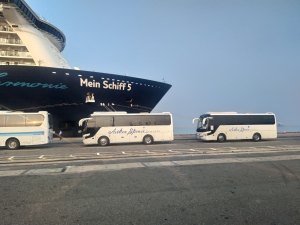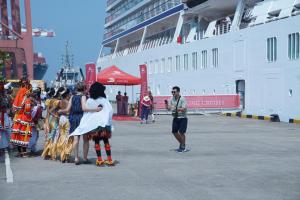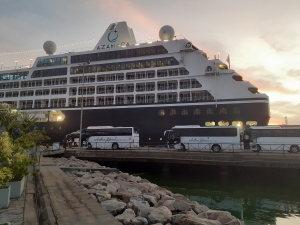Aitken Spence Travels recently revealed its plans to revive the local cruise tourism industry that has been devastated over the past two years due to the Covid-19 pandemic, by bringing down 10 cruise ships during the current winter season in addition to the three cruise ships that have already called at Sri Lankan ports.
This represents a hugely beneficial development to the local tourism industry, which is struggling to recover in the aftermath of the Covid-19 pandemic due to the economic, social, and political crisis in the country.
Revival of the industry
Speaking to The Sunday Morning Business, Aitken Spence Travels Managing Director Nalin Jayasundera stated that as the market leader in the local cruise tourism industry, Aitken Spence had already brought down three cruise ships – the Norwegian ‘Viking Mars,’ the German ‘Mein Schiff 5,’ and the ‘Azamara Quest’.
He further stated that Aitken Spence would be facilitating the arrival of 10 additional cruise ships during the current winter season and that these cruise ships were expected to do around 20-25 port calls in Sri Lanka.
“Although only 10 ships will be arriving, they are expected to make around 20-25 port calls in Sri Lanka. Some ships will call only at the Colombo Port while others will call at around two or three ports in Sri Lanka,” he explained.
Jayasundera explained that the local cruise tourism industry had been devastated by the 2019 Easter attacks and the Covid-19 pandemic which broke out in 2020, therefore, Aitken Spence had taken steps to revive the industry by promoting Sri Lanka as a cruise ship destination through its extensive network of contacts and its principals overseas.
Elaborating further, he stated that prior to the recent disruptions, the local cruise tourism industry had around 50-60 cruise ships calling at Sri Lankan ports during a year. However, over the past two years, cruise ship arrivals have fallen drastically. He asserted that the revival of this niche industry would be pivotal for the recovery of the local tourism industry as a whole.
He pointed out: “On average, an aircraft arriving in Sri Lanka will bring around 200 people and a maximum of 350 persons. In contrast, a cruise ship brings around 1,000 people. The recent German ‘Mein Schiff 5’ cruise ship had 2,000 passengers.
“While there might be fewer inland stays with cruise ships, they will call at several ports around the country and do shore excursions. For example, with regard to the ships that recently called at the Colombo Port, we organised excursions to Galle and Pinnawala. Once the highway is completed, we can organise excursions to Kandy and return in a day. Therefore, while the stay duration of cruise tourists might be lower, they will provide a good income to the country.”
Spreading the benefits
Jayasundera further stated that the business model implemented by Aitken Spence with regard to cruise tourism ensured that there was a diffusion of the benefits derived from these cruise ship arrivals to all stakeholders in the local tourism industry.
To that effect, Aitken Spence has retained the services of external tour guides, drivers, local entertainers, and transport operators on a freelance basis while also ensuring business opportunities for other local hoteliers, souvenir manufacturers, etc.
He explained that reviving the local tourism industry was of paramount importance and that Aitken Spence was committed to playing a role in its resurgence.
“Although Aitken Spence is bringing these cruise ships to Sri Lanka and providing shore excursion services, we are ensuring that ultimately it is not only Aitken Spence that benefits from this and that the benefits are diffused among all stakeholders. Therefore, the entire community of tourism stakeholders will derive benefits. While Aitken Spence may have generated the business, the benefits are not restricted to us,” Jayasundera explained.
Future prospects of the industry
Commenting on the future prospects of cruise tourism in Sri Lanka, Jayasundera stated that addressing the goods shortage and ensuring social and political stability were essential in order to provide cruise operators with the required confidence to view Sri Lankan ports as attractive ports of call in the long run.
He explained that cruise ships currently called at four ports in Sri Lanka – Colombo, Hambantota, Trincomalee, and Galle. According to him, if Sri Lanka is serious about promoting cruise tourism in the long term, it is essential that we establish a cruise terminal at one of the aforesaid ports.
“If we are serious about cruise tourism we must establish a dedicated cruise terminal at least at the Colombo Port. This can only be done by the Government. The Government should get together with the private sector and develop a cruise terminal under a Public-Private Partnership (PPP). This will signal to cruise operators that Sri Lanka is serious about cruise tourism,” he explained.
Jayasundera urged the Government, the Ministry of Tourism, and the Sri Lanka Tourism Promotion Bureau (SLTPB) to actively promote and market Sri Lankan ports as viable cruise destinations to foreign cruise operators. He explained that currently, the private sector consisting of Destination Management Companies (DMCs) was promoting Sri Lanka as a cruise destination. However, he pointed out that a cohesive strategy involving State participation would be more effective in marketing Sri Lanka as a cruise destination.
Speaking to The Sunday Morning Business, Sri Lanka Tourism Development Authority (SLTDA) Chairman Priantha Fernando stated that as per the 2023 Budget speech made by President Ranil Wickremesinghe, the promotion of marine tourism would be a priority in 2023. Accordingly, attention will be paid to the development of cruise tourism as part of the marine tourism promotional campaign.
Elaborating further, he stated: “In 2023, we will be targeting higher-end tourists with new products. Therefore, in addition to cruise tourism, we will be undertaking marine tourism, focusing on offerings such as yachting and diving. Cruise tourism is an attractive product because it brings in revenue and a large number of tourists. However, their average stay duration on the island is low.”
In his 2023 Budget speech, President Wickremesinghe stated: “New programmes have been introduced in many countries in various ways to attract tourists. However, there is a lack of approaches to developing maritime tourism considering the advantages of the location of Sri Lanka. Therefore, three maritime zones in the Eastern, Southern, and Western Provinces will be identified and the related infrastructure in those areas developed.
“Accordingly, the identification and development of safe sea areas for tourists to engage in sea-related activities in the shallow seas, the development of related infrastructure including anchoring bays for parking light yachts, necessary facilities for diving, and other related activities and food courts are required in this respect. The required funds for this purpose should be provided by the Tourism Development Fund. To initiate the process, I propose to allocate Rs. 50 million from the 2023 Budget.”
The pros and cons
Cruise tourism is essentially a form of enclave tourism, and it encompasses all facets of the tourism industry – accommodation, transportation, hospitality, and attractions. Cruising has become the fastest growing segment in the travel industry across the world and it’s no surprise given the wide variety of cruises on offer nowadays.
In essence, cruise tourism is a luxurious form of travelling, involving an all-inclusive holiday on a cruise ship for at least 24 hours, with a set and specific itinerary in which the cruise ship calls at several ports or cities. Cruise tourism is characterized by the concentration of large numbers of people who visit one particular destination at the same time.
This industry not only makes a large amount of income directly, but through its various industry partnerships and integrations, it also has the potential to reap significant financial rewards.
However, global reports also note that the reality is that this economic benefit is absorbed predominantly by the large corporations that own these cruise ships and there is very little economic benefit from cruise tourism to the destinations that host the tourists.
Since their every need is catered to onboard, cruise tourists typically don’t spend a lot of money at the destinations they visit, meaning that the local people reap few rewards from this type of tourism. In addition to this, cruise tourism can have devastating impacts on the natural environment when ships dock in shallow waters or when garbage is not disposed of responsibly.
Source: https://www.themorning.lk/articles/GuBk0vA6HCa0KVJQvvzk



